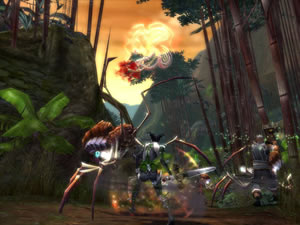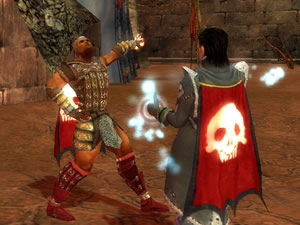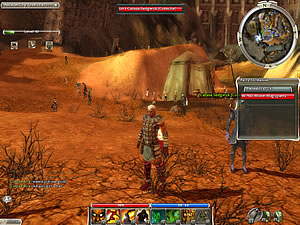How to own for free.
When we first heard that NCsoft subsidiary ArenaNet was creating a massively multiplayer RPG that wouldn’t charge a monthly fee, we were shocked and awed. The monthly fee is the achilles heel of the MMO scene, the cost of all that incredible content, really the only thing standing between games like World of Warcraft and world domination. If ArenaNet could truly pull off such a feat, I would seriously expect them to follow it up with a game that could feed me grapes.
Well, the wine industry can rest easy ” a fee-less MMORPG is still too good to be true. Instead we have Guild Wars, an online RPG with vivid graphics, dull PvE (player vs. environment) content and an extremely structured PvP (player vs. player) system. There is certainly a massive amount of gameplay here, just none of the cohesion or order required to make a game massively multiplayer.
The story casts you as an aspiring hero in the land of Tyria. When you first enter the scene, the grass is green, the castle pristine and the world pretty, but things quickly take a violent turn for the worse as an Orc-like race known as the Charr completely wipe out the kingdom, turning everything that was once beautiful into ruin and wasteland.
But before you save the day, you need to create a character. This is a simple process with few choices: sex, face, hair and class, so it won’t take long to make your avatar and log into the world. Upon arriving, you’ll find yourself in Ascalon City in the company of several similarly made avatars.
Just to be clear: Guild Wars is not a massively multiplayer game. The world is not persistent, featuring missions, levels and technology that turns it mostly into a single-player, co-operative experience. It looks like an MMO, but functions much, much more like the Champions of Norrath console games.
Towns are basically lobbies divided into several identical rooms called ‘districts’. When you arrive in one, you’ll see a drop-down window claiming you’re in one district out of about forty, all of which are mirrors. You can quickly jump into any of these as well as three international ones. The beauty of this system is that you can meet up with any friend anywhere in the world who also plays Guild Wars by sending them a message and warping to a district.
Towns generally include a few quest-givers, a vendor, a crafter, a materials person, a couple trainers and a lot of players. Once you leave town, though, the game tosses you and your party into an “instanced” environment. You won’t see any other players wandering the land at all, even if there were a hundred of them standing around you in town. It’s a little jarring, especially to veteran MMO players.
But this is only the first sign that Guild Wars isn’t the standard deal. Purchasing items is unusual in that you don’t simply buy them from a merchant. Instead, you buy a salvage kit and use it on items looted from enemy corpses, breaking them down into raw materials such as wood, fur, and steel. Then you head over to a crafter, who can turn your materials and money into equipment.
Unfortunately, the system doesn’t work very well because the economic model is broken. If you want, say, a pair of Ascalon boots, you’ll need 150 gold, a dozen iron ingots and a fur square. It turns out the fur is a pain in the ass to find, costing in upwards of 800 gold if you happen upon someone willing to sell. Trying to get it yourself could literally take days.
 If you actually go through the trouble, you can buy your new boots for what amounts to roughly 1000 gold. The re-sell value? A whopping 60 gold. Huh? That would make at least some kind of sense if it were some special uber-shoe, but the selection of purchasable items in Guild Wars is brutally limited, to say the least. Fifteen hours into the game, you’ll still only find a handful of weak weapons and armor for sale. Instead of a rich, deep item system with loads of fancy pants and swords, Guild Wars features needlessly complex reagent acquisition, few real items, and astonishingly no auction house to facilitate trade between players. Rather, you’ll have to search for or sell wares by screaming into the ‘trade’ chat channel.
If you actually go through the trouble, you can buy your new boots for what amounts to roughly 1000 gold. The re-sell value? A whopping 60 gold. Huh? That would make at least some kind of sense if it were some special uber-shoe, but the selection of purchasable items in Guild Wars is brutally limited, to say the least. Fifteen hours into the game, you’ll still only find a handful of weak weapons and armor for sale. Instead of a rich, deep item system with loads of fancy pants and swords, Guild Wars features needlessly complex reagent acquisition, few real items, and astonishingly no auction house to facilitate trade between players. Rather, you’ll have to search for or sell wares by screaming into the ‘trade’ chat channel.
Since you can’t rely on merchants for a snazzy new wand, you’ll have to acquire one through random luck, a collector or a quest. A collector is an NPC who trades weapons and armor for items that are routinely dropped by certain types of monsters. But even if a collector does have a wand, it’s rarely better than whatever you’re currently using. Quest rewards, meanwhile, are never class-specific, so you wind up getting lots of junk you don’t need.
Also, expect to acquire plenty of skills you won’t use. Say you’re a warrior who fancies himself a swordsman, and you acquire a few neat sword skills, but then quests give you three decent hammers and precisely zero swords. Ten hours into the game, you finally find a crafter who can make a halfway decent sword, but it isn’t remotely as effective as the hammer you acquired for completing one of your earlier quests. Looks like you’ll hammer all over this land and like it, buddy.
In turn, the game’s lack of a decent item economy can pigeonhole you into using skills and playing a type of character you wouldn’t have necessarily preferred. This highlights one of Guild Wars‘ most interesting traits ” its overall lack of organization. You should be able to specialize in hammers and buy various hammers while learning various hammer skills, but Guild Wars doesn’t work that way. Instead of encountering organized trainers and vendors who have whole lists of techniques and weapons to offer, you receive techniques and weapons at random and must allocate your skill points accordingly.
The game seems to be aware of this fact because it introduces the concept of skill point “refunds.” These allow you to change your skill points around to better suit your newly acquired skills or weapons. Since you can only have eight skills equipped at any time, this is a flexible system that encourages experimentation, which is helpful since there are quite a few skills to pick up along the way. This presumably makes up for the lame weapons and items, although that’s very debatable.
Eventually, you’ll get past such odd limitations and set off to save the land. You can go it alone or make a party with friends, random players, or free NPC henchmen. The henchmen are a wonderful idea because they guarantee that you’ll never have to solo as long as you play Guild Wars. No, they aren’t smart and you can’t command them at all, but they are a smooth, innovative touch that makes getting out and running quests a simple prospect.
 Leaving town with or without a party tosses you into an instanced segment of the world. Each section is persistent as long as you are within its confines, so if you kill all of the monsters in a given area, they won’t respawn as long as you stay in that section, but when you leave, everything is reset. This can lead to some frustration, especially when you need to travel through a certain region repeatedly and wind up fighting off the exact same enemies again and again.
Leaving town with or without a party tosses you into an instanced segment of the world. Each section is persistent as long as you are within its confines, so if you kill all of the monsters in a given area, they won’t respawn as long as you stay in that section, but when you leave, everything is reset. This can lead to some frustration, especially when you need to travel through a certain region repeatedly and wind up fighting off the exact same enemies again and again.
Actually, fighting monsters in Guild Wars is often a bit tedious. You use the same spells and attacks over and over as wave after wave of mindless menace descends upon you and your party. Expect to kill about four million ‘devourers’ within the first, of, twenty hours. Common tactical considerations such as tanking, pulling and aggro management are less important than simply dealing out damage as quickly as possible.
Overall, the PvE content just isn’t very exciting. Quests are numerous and easy, usually requiring you to travel to X, kill Y, and return to Z for your reward. You’ll run around with your party or henchmen, massacring endless torrents of mobs and collecting thrilling items like “Half-Eaten Mass” in a backpack that is way too small.
But once you reach level 20, you can port your character over to the PvP server for tournament action.
In a way, PvP in Guild Wars is a blast – if you are part of a guild you can enter domestic and national tournaments to test your geeky mettle. The match types themselves are pretty straightforward, including Capture the Flag, King of the Hill, and Team Deathmatch, but at least they exist.
If you don’t have a level 20 character, Guild Wars pleasantly provides an assortment of pre-made level 20s for testing the waters. They come with eight preset skills/spells and you can change their armor and skill foci, but in many cases the available skills seem like an arbitrary combination that don’t work together well. For example, one of the mage templates has five damage spells, all of which are on huge timers, but no basic direct-damage nukes or crowd control measures. He can’t escape an attack, nor is he capable of sustainable damage. It’s a gimp template.
 It’s also a free template, though, as is the entirety of this puppy after you get it home from the store. You won’t have to cancel your account because there is no monthly fee. You can play or not play Guild Wars as much and as little as you desire, because the game goes for a flat rate. For those concerned for our cash, we salute you!
It’s also a free template, though, as is the entirety of this puppy after you get it home from the store. You won’t have to cancel your account because there is no monthly fee. You can play or not play Guild Wars as much and as little as you desire, because the game goes for a flat rate. For those concerned for our cash, we salute you!
We’d also like to show you our capes. That’s right – if you create a guild and scrounge two thousand gold together, everyone gets capes designed by the guild leader. And the capes look awesome. Check out the dancing freaks with the pink skulls in that screenshot – they may or may not be GR employees.
Come to think of it, most of the game looks awesome thanks to the cool, scalable graphics. Textures and reflections are really impressive on high-end rigs, yet the game runs smoothly on just about anything that meets the minimum system requirements. Interestingly, towns are littered with stationary female player characters, probably because their owners are sitting transfixed by their own cleavage. Way to jubble, Guild Wars.
The sound effects aren’t nearly as impressive and the voice-work is minimal, although Jeremy Soule’s musical score is, as always, wonderful. Catchy but never grating, Soule’s work is some of the best in the industry.
While Guild Wars has little in common with an epic MMO like World of Warcraft, it does provide a wide array of online RPG content for a mere fraction of the cost. You can log in and quest with henchmen, kill mobs with friends, screw around in arenas, enter tournaments with guild-mates and endlessly agonize over the distribution of your skills and abilities. The story isn’t compelling, the PvE gameplay isn’t deep and it definitely won’t feed you grapes, but this double-edged sword mostly cuts the right way.
-
Repetitive combat and enemies
-
Underwhelming PvE
-
Lacks structure
-
Shallow, illogical economy
-
Worldwide tournaments
-
Good skill system
-
Runs flawlessly
-
Looks great
-
No monthly fee!







